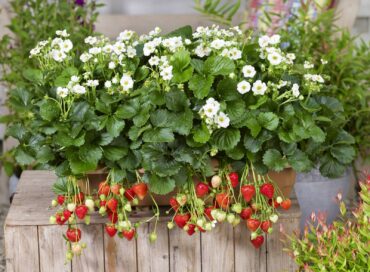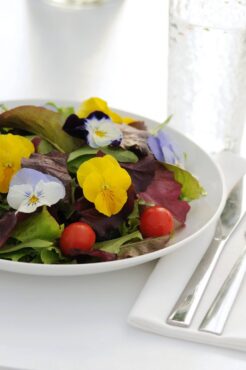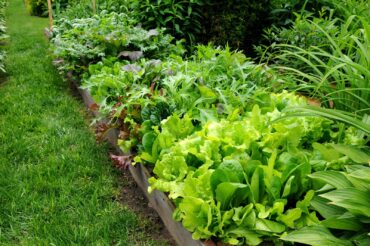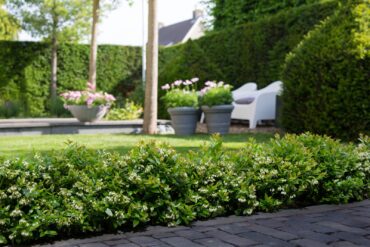
Peanut butter and jelly… Mac and cheese… Blake Lively and Ryan Reynolds… Perfect combinations make life a little happier. Just like favorite flavors and power couples, your garden can benefit from great combinations, too.
Who says veggies need to be relegated to the backyard? Beautifully blending veggies, fruit, herbs and flowers means you can show off your gorgeous combinations wherever you like: in the front landscape; planted along a walkway; dressing up your traditional kitchen garden; or placed on patios, porches or balconies.
No matter the size of your garden (or lack of green space), you can grow delicious edibles combined with ornamentals for garden-to-table meals and pretty displays. (Plus, have you seen some of the latest veggie introductions? They’re too beautiful to hide in the backyard!)
Whether you’re creating combination plantings to boost your veggie harvest by attracting pollinators, hoping to repel pests by adding aromatic herbs or just want to create a visually striking garden packed full of tasty treats and beautiful blooms, we’ve got some great ideas to get you started.
Mix-and-Match Edibles and Flowers for Gorgeous Combinations and a Productive Garden
Brighten Your Beds with Landscape Combination Plantings
Have you joined the foodscaping craze? Foodscaping — a landscape that incorporates edible plants — is a terrific way to grow delicious food, beautiful blooms and fabulous foliage all together. Not only does a foodscape create fantastic curb appeal, but it also helps reduce your grocery bill.
Many edible plants produce stunning foliage, as well as pretty edible veggies and fruit, making them a perfect addition to a front garden on their own. However, when you add them to beds or borders with traditional ornamental plants, the combinations make a stunning display. (Plus, a finicky homeowners’ association may be less likely to frown on front yard veggies.)
The most important consideration when mixing edibles and ornamentals in a foodscape involves pairing plants properly. Consider the plants’ needs before you start digging, and group plants with similar requirements together. Preferred light, moisture and soil pH are all important considerations for successful combination planting.
Give these landscape combinations a try.
Blueberries
Pretty delicate, spring flowers, scrumptious berries and lovely fall foliage — what’s not to love about blueberries? While they’re gorgeous all on their own, try combining them with other acid-loving plants, like azaleas, rhododendrons, Japanese anemones, Pieris japonica, camellias or hydrangeas.
While blueberries are self-fertile, planting a second variety helps boost harvests. Creating a rich, multilayered bed or border filled with beautiful fruit and flowers makes a stunning addition to landscapes.

Salad Greens
While you may typically line a walkway or garden path with charming pansies or colorful impatiens, why not add interest and texture with pretty, practical salad greens planted with annual flowers? Some veggies, like Swiss chard, make a striking display on their own, with a beautiful, vase-shaped structure and brilliant, colorful stalks. Others, like different types of lettuce, add an adorable display of charming, petite heads, neatly lining a path. Or plant cut-and-come-again lettuce for an ongoing, regrowing display and harvest.
Marry these cool-season greens with flowers that withstand a chill: violas, pansies, sweet alyssum, snapdragons, and spring phlox. You’ll love this tasty, beautiful border.
Fruit Trees
Who doesn’t love homegrown fruit? Whether you prefer an apple a day to keep the doctor away, sweet cherries or plump pears, the darling spring blooms of fruit trees delight pollinators and excite gardeners, anticipating delicious treats to come. The pretty flowers, followed by tasty fruit and colorful autumn foliage, make fruit trees a great choice for foodscaping.
Consider pairing fruit trees with flowering plants known both for fixing nitrogen in the soil, as well as attracting pollinators, such as blue false indigo, lupines, globe thistles, yarrow and artichokes. Artichokes make a terrific conversation starter: They add architectural interest to the landscape, produce delicious flower buds and attract pollinators when allowed to bloom.
Beginner tip: Choose companion plants with similar needs, such as light, soil and moisture.
Elevate Your Raised Bed Harvests with Combination Plantings
If you’re looking for a way to pack more punch into your raised beds, consider mixing up your usual neat rows of veggies with companion plants. You’ve probably heard the conventional wisdom that “tomatoes love basil,” or perhaps you know the native American story of the Three Sisters.

While there’s not much scientific, peer-reviewed evidence on the benefits of companion planting, most gardeners believe that adding flowers and flowering herbs to veggie beds helps boost harvests by attracting pollinators, while other plants produce scents that repel pests. Some plants work together for mutually beneficial results, like beans that fix nitrogen in the soil to benefit plants that need it for good growth and harvests.
Plus, who doesn’t enjoy a pretty veggie garden, with beautiful blooms mixed into homegrown goodies? When you plant your raised bed with a combination of veggies, fruit, herbs and flowers, you’re maximizing the space for high production — and pleasure.
Why not tuck in pretty coneflowers or daisies among the tomatoes, peppers and beans? They’ll attract pollinators, plus these homegrown flowers make a great garden-to-vase display to adorn garden-to-table meals.
Give these raised bed combinations a try.
Warm Season Garden
Indeterminate tomatoes can produce fruit throughout summer and into fall, but their tall vines may be unwieldy. Make sure to stake the plants to maximize space in your raised beds. Consider planting tomatoes in the middle of the bed (or toward the back, if the bed is against a fence), then surround the tomatoes with shorter veggies, herbs and flowers.
Tomatoes need full sun and rich, well-drained, evenly moist soil, so choose plants with similar needs. Layer the raised bed, with the tallest plants in the center (or back), surrounded by midsized plants, finally adding short or trailing plants along the outer edge of the raised bed.
Try a combination such as:
- Center: Tomatoes
- Middle: Basil, borage, peppers, eggplants, bush cucumbers or bush beans
- Edge: Strawberries, nasturtium, marigolds, trailing verbena or dwarf basil

Nasturtium, borage and marigolds make pretty, tasty additions to salads, as they’re edible flowers. They also attract pollinators to help boost harvests. Nasturtiums are also considered trap crops for pests, while marigolds and flowering basil attract beneficial insects that feast on pests, like aphids. Strawberries that dangle over the edge of a raised bed, rather than laying on the soil, are less likely to become slug snacks.
Beginner tip: Do not use pesticides on edible flowers in your combination plantings. Not only can pesticides harm beneficial insects, but the flowers also won’t be safe for human consumption.
Cool Season Garden
Extending your harvest season is a top priority, right? Summer’s waning days shouldn’t signal an end to homegrown treats. Instead, transition your raised bed garden to cool-season crops.
Try a combination such as:
- Center: Brussels sprouts
- Middle: Cabbage, Swiss chard, cauliflower, lettuce, snapdragons
- Edge: Carrots, radishes, parsley, cilantro, pansies, violas
Radishes are a perfect, quick crop, with most maturing in about 30 days from seed. Edible pansies and violas not only look pretty in raised beds, but they taste great adorning salads or desserts. Brussels sprouts require patience until harvest — but their tall stalks with adorable mini “cabbages” add interest to your garden — and your plate. Because cabbage loopers and cabbage worms enjoy nibbling on brassicas, consider adding a floating row cover over the bed to avoid pests.
Beginner tip: Make sure to provide good airflow for plants. Combining plants provides many benefits, but don’t overcrowd your bed. Plants still need good airflow for best health.
Create Beautiful, Practical Gardens Anywhere with Container Combinations
Think your garden is too small for homegrown food and flowers? Think again! With new introductions of dwarf, petite edible plants, you can enjoy an abundant harvest from patio containers, balcony windowboxes or even hanging baskets. With so many new containers to choose from, there is something for everyone.
The key for these small spaces is to keep the combination simple: Choose two or three plants to grow together for best results.
You’ve probably heard of the container design principle of “thriller, filler, spiller.” Well, it applies to growing edibles and ornamentals together, too. Choose a taller plant for the “thriller,” some midsized plants for the “filler” and trailing or vining plants for the “spiller.” Remember: Select plants with similar light, soil, temperature and water needs to keep the plants healthy and productive.
Let your imagination run wild:
- Love pizza? Combine a tomato plant (thriller), basil (filler) and oregano (spiller) in a container for homegrown ingredients.
- Eat salad at every meal? Plant peas on a center trellis (thriller), lettuce (filler), violas (filler) and strawberries (spiller) together for a sweet, healthy, pretty treat.
- Adore roses but lack garden space? Add a gorgeous miniature rose shrub to a container, then surround it with strawberries to spill over the sides.
- Or maybe you love packing flavor into your culinary creations. Plant drought-tolerant herbs like rosemary, oregano, thyme and lavender in a container with delosperma as a “spiller” for a lovely, practical herb garden.
Containers in Shade
If your space is more shady than sunny, no worries: Many greens and some herbs thrive in partial sun. Try a cool-season combination of kale, lettuce and pansies or Swiss chard, snapdragons and parsley for a gorgeous display and terrific harvest.
No matter your space, you’ll find hundreds of veggie, herb and flower varieties that make great combinations. Enjoy playing matchmaker in your garden: It’s fun to see which marriages produce the best results.




























Comments